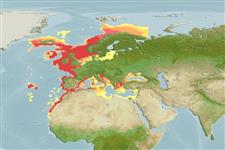Environment: milieu / climate zone / depth range / distribution range
Écologie
marin démersal; profondeur 18 - 1075 m (Ref. 58452), usually 70 - 400 m (Ref. 35388). Temperate; 76°N - 18°N, 30°W - 42°E (Ref. 58452)
Eastern Atlantic: Norway and Iceland, southward to Mauritania. Also in the Mediterranean Sea and along the southern coast of the Black Sea.
Length at first maturity / Taille / Poids / Âge
Maturity: Lm 42.3, range 20 - 70 cm
Max length : 140 cm TL mâle / non sexé; (Ref. 1371); common length : 45.0 cm TL mâle / non sexé; (Ref. 1371); poids max. publié: 15.0 kg (Ref. 1371); âge max. reporté: 20 années (Ref. 35388)
Épines dorsales (Total): 0; Rayons mous dorsaux (Total): 43-51; Rayons mous anaux: 36 - 40. Inside of mouth and branchial cavity black. Second dorsal and anal fins notched. First vertebra and neural spine attached to skull. Vertebrae 50-52.
Minimum depth from Ref. 128002. Found usually between 70 and 370 m depth. Adults live close to the bottom during day-time, but move off-bottom at night. Adults feed mainly on fish (small hakes, anchovies, pilchard, herrings, cod fishes, sardines and gadoid species) and squids. The young feed on crustaceans (especially euphausiids and amphipods). Are batch spawners (Ref. 51846). Almost entirely marketed fresh, whole or filleted, to specialized restaurants or retail markets (Ref. 58452). Utilized fresh, dried or salted and frozen; can be steamed, fried, microwaved and baked (Ref. 9988). Stocks seem to be over-fished (Ref. 35388).
Continuous recruitment of oocytes connotes indeterminate fecundity for this species (Ref. 79799).
Cohen, D.M., T. Inada, T. Iwamoto and N. Scialabba, 1990. FAO species catalogue. Vol. 10. Gadiform fishes of the world (Order Gadiformes). An annotated and illustrated catalogue of cods, hakes, grenadiers and other gadiform fishes known to date. FAO Fish. Synop. 125(10). Rome: FAO. 442 p. (Ref. 1371)
Statut dans la liste rouge de l'IUCN (Ref. 130435)
Menace pour l'homme
Harmless
Utilisations par l'homme
Pêcheries: hautement commercial
Outils
Articles particuliers
Télécharger en XML
Sources Internet
Estimates based on models
Preferred temperature (Ref.
123201): 6.9 - 15.4, mean 10.2 °C (based on 672 cells).
Phylogenetic diversity index (Ref.
82804): PD
50 = 0.5000 [Uniqueness, from 0.5 = low to 2.0 = high].
Bayesian length-weight: a=0.00479 (0.00431 - 0.00531), b=3.12 (3.09 - 3.15), in cm total length, based on LWR estimates for this species (Ref.
93245).
Niveau trophique (Ref.
69278): 4.4 ±0.0 se; based on diet studies.
Generation time: 9.0 (7.9 - 10.1) years. Estimated as median ln(3)/K based on 95
growth studies.
Résilience (Ref.
120179): Milieu, temps minimum de doublement de population : 1,4 à 4,4 années (K=0.07-0.3; tmax=20; Fecundity=7 million).
Prior r = 0.53, 95% CL = 0.35 - 0.80, Based on 16 stock assessments.
Fishing Vulnerability (Ref.
59153): High vulnerability (65 of 100).
Climate Vulnerability (Ref.
125649): Moderate vulnerability (39 of 100).
Nutrients (Ref.
124155): Calcium = 8.42 [4.50, 24.86] mg/100g; Iron = 0.22 [0.08, 0.52] mg/100g; Protein = 17.7 [16.7, 18.7] %; Omega3 = 0.248 [0.172, 0.355] g/100g; Selenium = 34.6 [19.1, 64.2] μg/100g; VitaminA = 11.8 [3.4, 39.2] μg/100g; Zinc = 0.246 [0.175, 0.341] mg/100g (wet weight); based on
nutrient studies.
